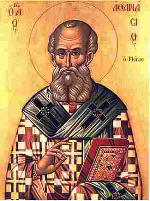
The Paradise Of The Holy Fathers Volumes 1 and 2 by Saint Athanasius Of Alexandria
THE ASKETIKON OF PACHOMIUS
1. ON PRIDE AND WICKEDNESS.
2. SYLVANUS the Actor.
3. The SINNER who died.
4. The RIGHTEOUS MAN who died.
5. What the DEVILS SAID TO PACHOMIUS.
6. The ACTS OF PACHOMIUS in his Monastery.
7. A REVELATION concerning heretics.
8. A REVELATION concerning the Settlement of the Brethren.
9. ANOTHER REVELATION.
10. WORDS OF DOCTRINE.
11. THE FAMINE.
12. PACHOMIUS and the Steward.
13. The MONK WHO DENIED CHRIST.
14. PACHOMIUS and the PHANTOM.
15. PACHOMIUS and his GIFT OF TONGUES.
16. JONAH the Gardener.
17. PACHOMIUS and HIS ORATORY.
18. PACHOMIUS and THE HERETICS.
19. PACHOMIUS and THE MONK.
20. PACHOMIUS and the MONK WHO MADE MATS.
21. PACHOMIUS and the MONK WITH CUT HANDS.
FURTHER REMARKS BY PALLADIUS.
Following the above we have in the Syriac version of Ânân-Îshô a HISTORY OF THE MONKS WHO LIVED IN THE DESERT OF EGYPT, which is said to have been compiled by Saint Jerome. This work is generally known as the Historia Monachorum, and was written in Greek; the Latin version is now acknowledged to have been made by Rufinus. It has been shown (Butler, Lausiac History, p. 276, Cambridge, 1898) that it was compiled by a Monk of Jerusalem, who belonged to the monastery on Mount Olivet founded by Rufinus, and who went to Egypt in 394, with six companions, to visit the monks. On his return to his monastery he wrote the book at the request of the brotherhood. According to Sozomen the writer was Timotheus, Bishop of Alexandria, but Dom Butler has proved this to be impossible, and he suggests (op. cit., p. 277) that the writer was not the Bishop of Alexandria, but the Archdeacon of Alexandria, who was also called Timotheus, and was put forward by his party, on the death of Bishop Theophilus in 412, as a candidate for the see against St. Cyril. The contents of his work are:
1. The Author’s APOLOGY.
2. JOHN OF LYCUS.
3. ABBÂ HOR.
4. ABBÂ AMMON.
5. ABBÂ ABBAN (BENUS).
6. THE BRETHREN OF OXYRRHYNCHUS.
7. ABBÂ THEON.
8. ABBÂ ELIJAH.
9. ABBÂ APOLLO and ABBÂ AMMON.
10. ABBÂ APELLEN.
11. ABBÂ APOLLO and ABBÂ JOHN.
12. ABBÂ PAPHNUTIUS.
13. EULOGIUS.
14. ISIDORE of Thebes.
15. DIOSCURUS of Thebes.
16. ABBÂ COPRES and PETARPEMOTIS.
17. HÔR, ISAIAH, PAUL, and NOPI, the Confessors.
18. EVAGRIUS.
19. PITHYRION.
20. TRIUMPHS OF THE FATHERS.
21. THE MONKS OF NITRIA.
22. AMMON THE FIRST.
23. Another AMMON.
24. DIDYMUS.
25. CHRONIUS.
26. The THREE BRETHREN who cut off their ears.
27. PHILEMON.
28. JOHN, Abbâ of Dîkâpôlîs.
29. SERAPION, the head of ten thousand men.
30. APOLLO the Less.
The Second Part of Ânân-Îshô’s version of the book Paradise contains several series of miscellaneous collections of “Sayings” and “Stories” of the Fathers, some 635 in number, and also a series of “Questions and Answers,” about 706 in number, which deal with the rule of life of the holy men. Though Ânân-Îshô attributes all of them to Palladius, it is very doubtful if more than a few of them were collected by him. Large numbers of them are found in Greek manuscripts of the sixth century, and it is almost certain that the “Sayings” were first collected and done into writing in the fifth century, probably about the time when the book Paradise and History of the Monks were compiled. It is only natural that the men who wrote these works should think that the terse, pithy “Sayings” of the ascetics whom they had visited were just as well worth preserving as the histories of their lives, and that they should take pains to put on record the words and opinions on difficult points of the ascetic life for the benefit and guidance of future generations of monks. It is, in my opinion, quite impossible for all the “Sayings” and “Stories” collected by Ânân-Îshô to belong to this early period or to be of Egyptian origin, but it is certain that a very large proportion of them is of Egyptian origin, and that the teaching and spirit in all of them are the products of the Christian monasticism of Egypt. On the other hand, the authorship of many of them is doubtful, and this we must probably attribute to the mistakes of copyists. When the “Sayings” were first collected, they were grouped either according to the names of their authors or their subject matters; but these arrangements were soon broken up, and after a generation or two anything like systematic order disappeared from the collections. The “Sayings” and the “Stories” of the monks translated in the second volume of this work are of great value for the study of Egyptian monastic Christianity, for they reveal the very thoughts of the ascetics and illustrate the views of the monks on almost every conceivable point in connexion with the theory and practice of the Christian Life as they understood it. In them we have depicted the strength and weakness of the holy men, and though our modern ideas may suggest that selfishness was at the bottom of their stern asceticism, that their labours did nothing to help the world along, and that their hardships and the torturings of their bodies were both useless and unnecessary, no one can deny that the fixedness and intensity of their faith, and their high aims and practical morality made them bright lights and guides to all, and proved them to be most earnest seekers after God.
Copyright ©1999-2023 Wildfire Fellowship, Inc all rights reserved

 Keep Site Running
Keep Site Running